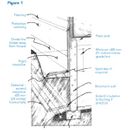Frost skirt or full depth exterior basement insulation retrofit?
As the mercury dips to -40C here in Winnipeg my thoughts go to adding insulation to my cold and drafty 1920s bungalow. My local utility has an insulation guide and the give two options for exterior basement insulation, dig down to the footing and add the insulation to the full height of concrete or go two feet below grade and then two feet out from the foundation to create a frost skirt similar to a frost protected shallow foundation.
My question is would the frost skirt option provide good thermal preformace?
GBA Detail Library
A collection of one thousand construction details organized by climate and house part










Replies
Jotham,
Either option will be a significant improvement over your current situation. For information on protecting the above-grade portion of the insulation, see this article: "How to Insulate a Basement Wall."
Jotham, my thoughts on exterior insulation are that going to the footing is a waste of time. The bottom of the foundation wall is thermally connected to the footing, so even if you take the unsulation all the way down the concrete foundation wall will only get as warm as the footing. For at least some significant distance above the footing anyway. This is why I don't believe in the considerable added expense of an ICF foundation; half of your insulation is only really functional above grade.
My personal approach for our new build will be to insulate the outside of the foundation wall from the sill plate to about 18" below grade (fill to 30" from the top of the wall and use 48" foam panels 2" thick). Our building code only requires R20 interior basement wall insulation, the first 2" of which is to be continuous foam.
My approach makes sense (to me) because it insulates the above-grade basement wall from the cold outside air (the biggest concern) and allows the remaining wall and footing below grade to remain no colder than the average soil temperature, which should be comfortably above freezing.
We're in Ottawa, not quite -40 but we do get to -30 from time to time. In the townhouse we're living in now, the above-grade foundation walls light up like heating elements when viewed through the lens of an IR camera.
Lance Peters
Thanks for your insights!
Hi Jotham -
I tend to agree with both Martin and Lance. The delta-T between your basement and the soil 8 feet down is not that great, especially given the effort and cost to go all the way to your footing.
Unless you have some other reason for going all the way down, such as a moisture problem in your basement related to bulk water management below grade, get the lions' share of the benefit by insulating the portion of your foundation that is above-grade and then the next two feet down where the delta-T justifies it.
Peter